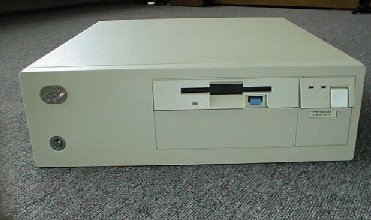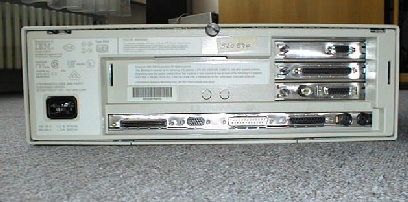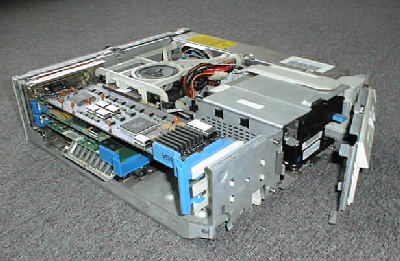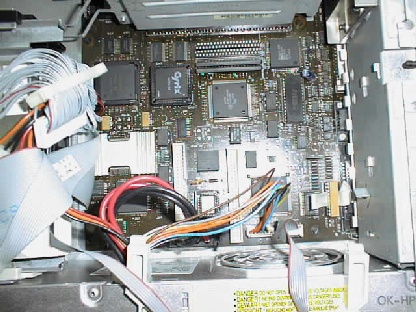
Click here or click onto the photo for a full size version of this picture.
The 386SLC processor was IBM's first attempt to improve the performance of 386SX-based systems without having to change the system board around it. The result is an internal cache of 16 Kbytes to compensate for the slow and narrow memory interface (this is more than the first 486's had!), and a slightly improved CPU core. The result is measurable, but it won't blow you out of your shoes. In my own applications, I measured an improvement of roughly 50% compared to the same system equipped with a 386SX/20 (your mileage may vary, as always...). The 486SLC[2,3] that came later gave a much more significant boost, due to the 486-like CPU core and the internal clock multiplier.
The 56SLC has the standard PS/2 peripherals on-board, as can be seen in the next photo showing its back:

Click here or click onto the photo for
a full size version of this picture.
From the left to the right, we have an external SCSI connector (wow, on-board SCSI, however with an IBM-proprietary connector :-/), VGA, one serial and one parallel port, and last but not least keyboard and mouse. The two round break-out holes are provided for adding a U-shaped bolt. This bolt allows you to tie the machine to the table it is standing on via a chain and a lock or something similar.

Click here or click onto the photo for
a full size version of this picture.
The Model 56 has a quite compact case which puts some restrictions about how components are placed in it. The three Microchannel(tm) slots are oriented horizontally and the three SIMM slots are 45-degree types to make the modules fit under the bottommost expansion card. The SIMM slots accept an arbitrary mixture of 8M and 4M boards, but of course you will never get more than 16Mbytes of RAM - the CPU cannot address more...
At the front, there is room for the floppy drive and one 5,25-inch, half-height drive. 5,25-inch drives are held via the typical rails screwed to the left and right of the drive, while the 3,5-inch drive in this machine is held by a special snap-in holder on the chassis' bottom. Both drive's front covers are held in a common metal frame that can simply be snapped off (like in this picture).
The place behind the drives is mostly unused; only a large speaker uses it as 'resonance space'. IBM learned to exploit this space in later model variants by moving the speaker to the free space under the microchannel cards in the case's front and hooking in a special metal holder for a single 3,5 inch, 1 inch height hard drive (the 160M drive used in this machine has a height of 1.6 inch and wouldn't fit anyway...).
The power supply is DC-controlled, so the power switch is a low-voltage type; I haven't however found up to now a method to turn the machine on and off in software...).

Click here or click onto the photo for
a full size version of this picture.
The CPU has to hide itself under a large cooling plate (left edge of the board's visible part). Floppy and internal SCSI connector are pulled off to get a better view onto the board. A little mystery circumvents the two empty sockets for VRAM memory: You can put in another 256K of RAM, and IBM's test program in fact then reports the 512K video memory. I haven't found however any way to exploit the larger video memory, and the usual way to replace the on-board standard VGA was to put in a graphics accelerator into one of the slots (an XGA-1 in this case, the long card in the topmost slot).
- Processor:
- IBM 386SLC @ 20 MHz
- Coprocessor:
- Cyrix 83S87 @ 20 MHz
- Cache:
- 16K internally in CPU
- Memory:
- 12 Mbytes (options range from 4M to 16M)
- Bus:
- 3 MCA slots (16 bit)
- Interfaces (onboard):
-
- Mouse, Keyboard
- 1x Serial
- 1 x Parallel
- Floppy (2.88M), allows attachment of up to 3(!) drives
- SCSI (narrow)
- VGA (extendable to 512K VRAM ?)
- Add-on cards:
-
- 3COM 3C523 Ethernet Adapter
- IBM XGA Video Adapter
- AMS Parallel/Serial card
- Operating System(s):
-
- Linux 2.0 (Slackware-based)
- Useful Links: